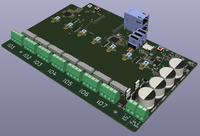Difference between revisions of "Colibri"
Jump to navigation
Jump to search
| Line 29: | Line 29: | ||
| Ready for prototype | | Ready for prototype | ||
|- | |- | ||
| − | | [[File:colibri-2-RevA-front3d.png]] | + | | [[File:colibri-2-RevA-front3d.png|220px]] |
| [[Colibri-2]] | | [[Colibri-2]] | ||
| Colibri Host | | Colibri Host | ||
| Line 35: | Line 35: | ||
| Ready for prototype | | Ready for prototype | ||
|- | |- | ||
| − | | [[File:colibri_aic-RevA-front3d.png]] [[File:colibri_aic-RevA-back3d.png]] | + | | [[File:colibri_aic-RevA-front3d.png|220px]] [[File:colibri_aic-RevA-back3d.png|220px]] |
| [[Colibri AIC]] | | [[Colibri AIC]] | ||
| I/O Expansion | | I/O Expansion | ||
| Line 41: | Line 41: | ||
| Ready for prototype | | Ready for prototype | ||
|- | |- | ||
| − | | [[File:colibri_aiv-RevA-front3d.png]] [[File:colibri_aiv-RevA-back3d.png]] | + | | [[File:colibri_aiv-RevA-front3d.png|220px]] [[File:colibri_aiv-RevA-back3d.png|220px]] |
| [[Colibri AIV]] | | [[Colibri AIV]] | ||
| I/O Expansion | | I/O Expansion | ||
| Line 47: | Line 47: | ||
| Ready for prototype | | Ready for prototype | ||
|- | |- | ||
| − | | [[File:colibri_aqv-RevA-front3d.png]] [[File:colibri_aqv-RevA-back3d.png]] | + | | [[File:colibri_aqv-RevA-front3d.png|220px]] [[File:colibri_aqv-RevA-back3d.png|220px]] |
| [[Colibri AQV]] | | [[Colibri AQV]] | ||
| I/O Expansion | | I/O Expansion | ||
| Line 53: | Line 53: | ||
| Ready for prototype | | Ready for prototype | ||
|- | |- | ||
| − | | [[File:colibri_diu-RevA-front3d.png]] [[File:colibri_diu-RevA-back3d.png]] | + | | [[File:colibri_diu-RevA-front3d.png|220px]] [[File:colibri_diu-RevA-back3d.png|220px]] |
| [[Colibri DIU]] | | [[Colibri DIU]] | ||
| I/O Expansion | | I/O Expansion | ||
| Line 59: | Line 59: | ||
| Ready for prototype | | Ready for prototype | ||
|- | |- | ||
| − | | [[File:colibri_pid-RevA-front3d.png]] [[File:colibri_pid-RevA-back3d.png]] | + | | [[File:colibri_pid-RevA-front3d.png|220px]] [[File:colibri_pid-RevA-back3d.png|220px]] |
| [[Colibri PID]] | | [[Colibri PID]] | ||
| I/O Expansion | | I/O Expansion | ||
| Line 65: | Line 65: | ||
| Ready for prototype | | Ready for prototype | ||
|- | |- | ||
| − | | [[File:colibri_pt1000-RevA-front3d.png]] [[File:colibri_pt1000-RevA-back3d.png]] | + | | [[File:colibri_pt1000-RevA-front3d.png|220px]] [[File:colibri_pt1000-RevA-back3d.png|220px]] |
| [[Colibri PT1000]] | | [[Colibri PT1000]] | ||
| I/O Expansion | | I/O Expansion | ||
| Line 71: | Line 71: | ||
| Ready for prototype | | Ready for prototype | ||
|- | |- | ||
| − | | [[File:colibri_rs485u-RevA-front3d.png]] [[File:colibri_rs485u-RevA-back3d.png]] | + | | [[File:colibri_rs485u-RevA-front3d.png|220px]] [[File:colibri_rs485u-RevA-back3d.png|220px]] |
| [[Colibri RS485u]] | | [[Colibri RS485u]] | ||
| I/O Expansion | | I/O Expansion | ||
| Line 77: | Line 77: | ||
| Ready for prototype | | Ready for prototype | ||
|- | |- | ||
| − | | [[File:colibri_ssr-RevA-front3d.png]] [[File:colibri_ssr-RevA-back3d.png]] | + | | [[File:colibri_ssr-RevA-front3d.png|220px]] [[File:colibri_ssr-RevA-back3d.png|220px]] |
| [[Colibri SSR]] | | [[Colibri SSR]] | ||
| I/O Expansion | | I/O Expansion | ||
| Line 83: | Line 83: | ||
| Ready for prototype | | Ready for prototype | ||
|- | |- | ||
| − | | [[File:colibri_triac1-RevA-front3d.png]] [[File:colibri_triac1-RevA-back3d.png]] | + | | [[File:colibri_triac1-RevA-front3d.png|220px]] [[File:colibri_triac1-RevA-back3d.png|220px]] |
| [[Colibri TRIAC1]] | | [[Colibri TRIAC1]] | ||
| I/O Expansion | | I/O Expansion | ||
Revision as of 14:25, 18 January 2023
Colibri is a low-cost automation system, primarily intended for building automation, home automation, energy supervision, agriculture supervision and similar systems. Main features beside costs are;
* Flexible I/O system, via Expansion Cards in M.2 Key E sockets. * Power supply of 7-36 Volt, either AC or DC (some expansion cards won't work with DC supply) * Colibri-1 using LoraWAN for communications. * Colibri-2 is a full-fledged Raspberry Pi, built with Compute Module 4 (CM4)
Form Factor
Colibri expansion boards are 22x42mm and has an edge connector called M.2 Key E. Many of the pins are following the Key E standard, but Colibri boards have additional requirements, which is not available in the official standard.
WARNING!!! DO NOT PLUG COLIBRI EXPANSION BOARDS INTO OTHER EQUIPMENT, NOR ANY M.2 BOARDS INTO THE COLIBRI SYSTEM THAT WERE NOT SPECIFICALLY MADE FOR COLIBRI.
Planned Boards
| Name | Type | Description | Status | |
|---|---|---|---|---|
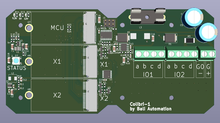
|
Colibri-1 | Colibri Host | MCU Board using the STM32F405 MCU | Ready for prototype |
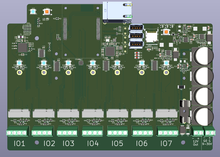
|
Colibri-2 | Colibri Host | MCU Board using the STM32F446 MCU | Ready for prototype |
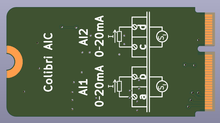 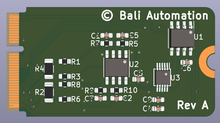
|
Colibri AIC | I/O Expansion | Two analog 0-20mA inputs | Ready for prototype |
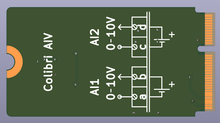 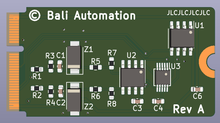
|
Colibri AIV | I/O Expansion | Two analog 0-10V inputs | Ready for prototype |
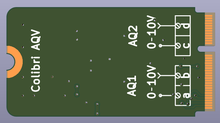 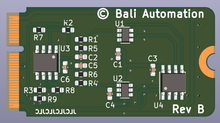
|
Colibri AQV | I/O Expansion | Two analog 0-10V outputs | Ready for prototype |
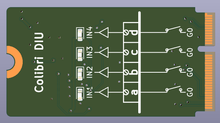 
|
Colibri DIU | I/O Expansion | Four digital inputs, for state, counter, pulsewidth measurement | Ready for prototype |
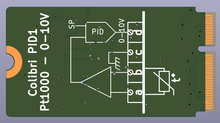 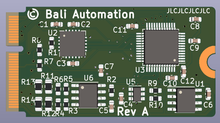
|
Colibri PID | I/O Expansion | PID regulator, with a PT1000 input and a 0-10V analog output | Ready for prototype |
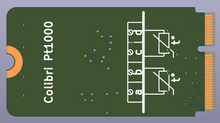 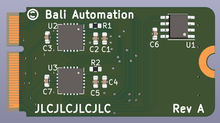
|
Colibri PT1000 | I/O Expansion | Two PT1000 temperature sensor inputs. | Ready for prototype |
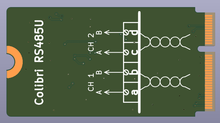 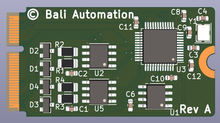
|
Colibri RS485u | I/O Expansion | Two non-isolated RS-485 ports. | Ready for prototype |
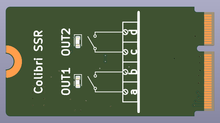 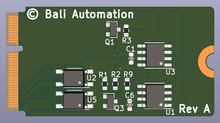
|
Colibri SSR | I/O Expansion | Two Solid State Relays, ON/OFF. | Ready for prototype |
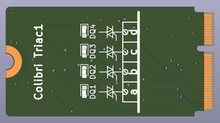 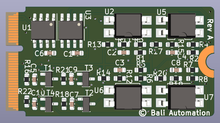
|
Colibri TRIAC1 | I/O Expansion | Four Triac outputs, driving 24V AC. | Ready for prototype |
